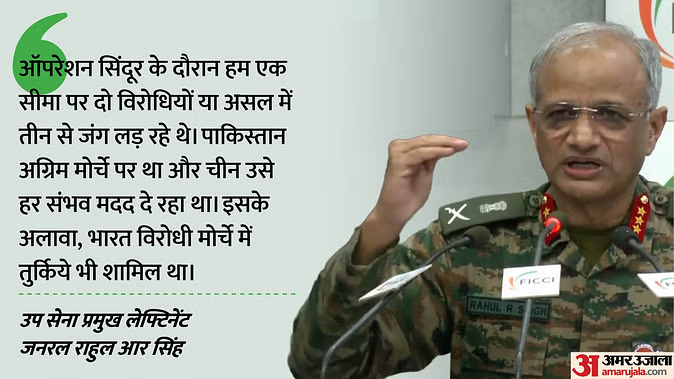By :- Shruti Tiwari
In a startling revelation, Indian Army’s Deputy Chief (Capability Development and Sustenance), Lieutenant General Rahul R Singh, exposed a strategic collusion between China, Pakistan, and Turkey during Operation Sindoor. Speaking at the FICCI’s ‘New Age Military Technologies’ event, Lt Gen Singh stated that during the operation, China was providing real-time intelligence to Pakistan on India’s forward deployments and strategic vectors.
China-Pakistan-Turkey Nexus Uncovered
Lt Gen Singh said that while Director General of Military Operations (DGMO)-level talks were ongoing, China was continuously updating Pakistan with live surveillance data of India’s military movements. He stressed the urgent need to enhance technological capabilities and counter such surveillance threats.
Highlighting the growing tri-nation alliance, he revealed that Operation Sindoor wasn’t a conventional two-front confrontation. “In fact, we were fighting a three-pronged challenge – Pakistan was on the frontline, receiving extensive support from China, and Turkey also played a significant role,” he said.
He noted that 81% of Pakistan’s military hardware is Chinese, and the operation exposed how China was using Pakistan as a testbed to evaluate its weapon systems against Indian defence technologies. “Turkey too provided key assistance during the operation,” he added.

Live Target Selection and Precision Strikes
Describing India’s precision in target selection, Lt Gen Singh shared that during the operation, a total of 21 targets were shortlisted in Pakistan based on a blend of human intelligence and technological inputs. In a last-hour strategic decision, only 9 targets were finalized for the military strike, ensuring maximum impact with minimal escalation.
“This decision was part of an integrated tri-services approach aimed at sending a strong message to the world – that India’s armed forces are unified and strategic in their response,” Singh said.
Strategic Messaging and Ceasefire Calculations
Lt Gen Singh emphasized that Operation Sindoor served as a bold message from India’s leadership to its adversaries – that the era of tolerating cross-border terrorism is over. He described Pakistan’s eventual call for a ceasefire as a “tactical retreat,” noting that the Indian Army was fully prepared for escalation, and Pakistan feared a worsening scenario.
“Initiating war is easy, but managing it is extremely difficult. Pakistan realized that if conflict continued, India’s punch was ready, and the situation could worsen dramatically for them,” he stated.
Need for Robust Air Defence in Civilian Areas
Another critical lesson from Operation Sindoor, Singh highlighted, was the need to fortify air defence systems in civilian areas. “Though our air defence performance during the operation was excellent, it lacked depth in populated zones. Future conflicts may target such areas, so preparations must begin now,” he warned.
Conclusion:
Operation Sindoor has not only showcased India’s military readiness and technological advancement but also exposed the deepening nexus between China, Pakistan, and Turkey. With evolving geopolitical threats, India’s strategic posture and integration of armed forces continue to adapt rapidly, sending a clear message that national security remains non-negotiable.

